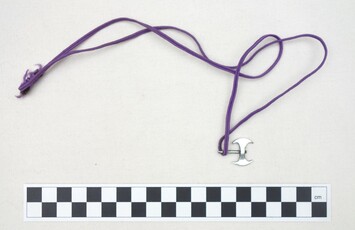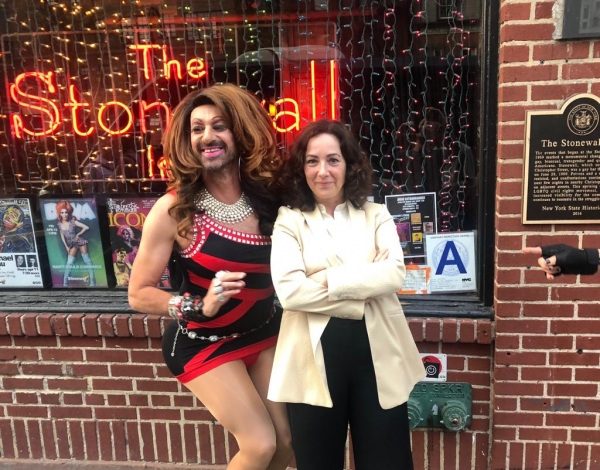Textiles tell stories. The Textile Research Centre (TRC) in Leiden has organized this online exhibition to celebrate a few of the stories of LGBTQ+ people and to explore the connection between dress, gender and identity. From rainbow flags to glittery drag costumes, T-shirts to silk ties, the textiles in the TRC collection tell stories of struggle and pride.
The way we dress reveals the communities we belong to, or aspire to belong to. Dress shows how we see ourselves and how we want others to see us. It signals gender, age, and availability for a relationship. Dress has always been a marker of identity, a way to place yourself in society—and a way you are placed by others.
For LGBTQ+ people, dress has historically been a way to maintain an identity and to identify each other in often hostile environments. Dress functioned as a code, recognized only by those in the know. The code may have involved wearing a certain colour or article of clothing, an accessory such as a flower or piece of jewellery, or clothes usually worn by another gender. All of this has been used at one time or another by LGBTQ+ people to send messages, to create community, to fight invisibility and prejudice, and often to simply proclaim “I exist”.

A more discrete signal was to wear a red tie (click here). Around the same time violets and the colour purple became associated with lesbians. This may have been based on the poetry of the ancient Greek poet Sappho of Lesbos (c. 630-575 BCE).
Sappho’s poetry often refers to women loving women, and also to female lovers wearing crowns of violets (Sappho’s name gave rise to words such as sapphist (lesbian) and sapphism (lesbianism) while the word lesbian comes from her birthplace, the island of Lesbos (See The Sappho Companion, by Margaret Reynolds. 2000, Chatto & Windus Random House, London). In the 1926 play La Prisonnière by Édouard Bourdet a bouquet of violets alluded to lesbian love. When the play was censored by French authorities, Parisian lesbians wore violets to protest.
 Turquoise net costume, with silver coloured braids and hand applied turquoise sequins, donated by Jennifer Hopelezz. Early 21st century, Netherlands (TRC 2019.1622). For more information, click on the illustration.Such codes are still in use today, especially in countries where same-sex relationships are criminalized. The symbols used may be very localized and change over time. In a BBC interview (February 2019) with lesbians in Burundi, the women spoke of fears of being ostracized, imprisoned or killed by families or neighbours if their sexuality became known. Many of the lesbians wore jeans and T-shirts at a monthly meeting. The T-shirts differed in style, patterns and colours, journalist Megha Mohan explained, but were important because each shirt bore the same discrete identifying mark in its design. The symbol was “an in-joke – a sign of their identity and independence. Something only they understand,” Mehan wrote. In the report the symbol is referred to as a violet, which is not actually used by any LGBTQ+ group in Burundi or elsewhere in East Africa. The violet was chosen by the journalist as it was used by lesbians in the 1900s (click here).
Turquoise net costume, with silver coloured braids and hand applied turquoise sequins, donated by Jennifer Hopelezz. Early 21st century, Netherlands (TRC 2019.1622). For more information, click on the illustration.Such codes are still in use today, especially in countries where same-sex relationships are criminalized. The symbols used may be very localized and change over time. In a BBC interview (February 2019) with lesbians in Burundi, the women spoke of fears of being ostracized, imprisoned or killed by families or neighbours if their sexuality became known. Many of the lesbians wore jeans and T-shirts at a monthly meeting. The T-shirts differed in style, patterns and colours, journalist Megha Mohan explained, but were important because each shirt bore the same discrete identifying mark in its design. The symbol was “an in-joke – a sign of their identity and independence. Something only they understand,” Mehan wrote. In the report the symbol is referred to as a violet, which is not actually used by any LGBTQ+ group in Burundi or elsewhere in East Africa. The violet was chosen by the journalist as it was used by lesbians in the 1900s (click here).
Many contemporary bisexuals have adopted the colour purple as a symbol, which earlier was associated with lesbians. Mezzo-soprano Jamie Barton wore a specially designed purple, pink and blue gown, the colours of the bisexual flag, to express pride during her final performance at the 2019 Last Night at the Proms in London’s prestigious Royal Albert Hall. She also waved a rainbow flag. Other sexual minorities use different symbols. A black ring, worn on the middle finger of the right hand, is increasingly used by people who identify as asexual. Called an ‘ace’ ring (from ‘asexual’), the ring is a marker of identity, as activist Emi Salida explains: “It personally reminds me that I am not alone, even if I feel alone…that I am valid, even if I don’t feel this way. It is a really reassuring symbol for me” (click here).
Colophon:
- Author: Shelley Anderson
- Web-design: Joost Koopman
- Exhibition design: Willem Vogelsang
- Publisher: TRC Leiden.
- Year of publication: 2020
- Copyright: All illustrations of objects housed in the TRC collection can be used free of charge, but please add to the caption: "Courtesy Textile Research Centre, Leiden" and the pertinent accession number of the object.

